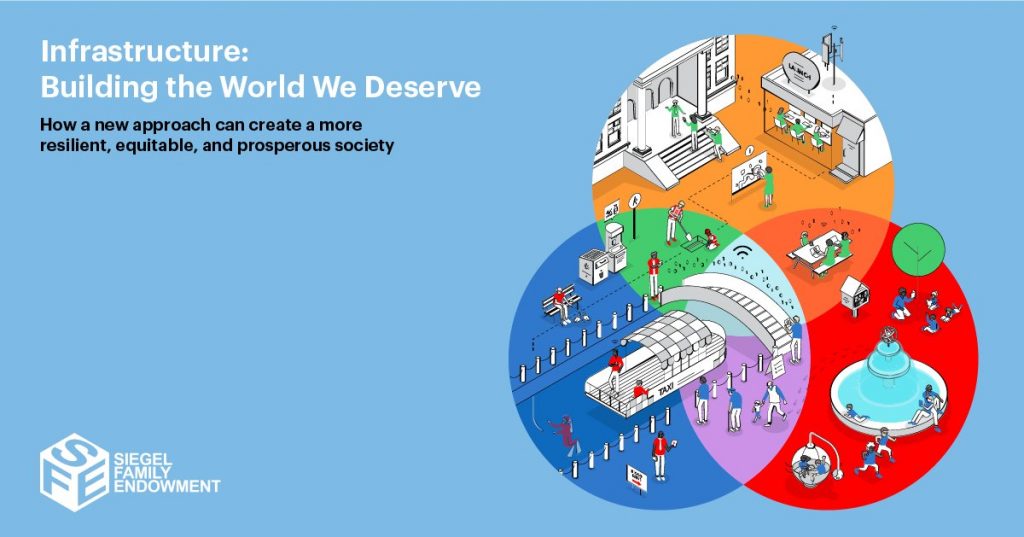In October 2020, the Siegel Family Endowment (“Siegel”) released a white-paper, Rebuilding America: The Road Ahead, highlighting how infrastructure can support a more resilient, equitable, and prosperous society. As stated in the paper, “broadband … and new technologies that become vital to human progress.” It also determines which communities will be economically viable, attract innovation, and allow residents to age in place.
For centuries, governments have invested in physical infrastructure to connect people, provide services, and create a more efficient society. This began with the Roman aqueducts and continues today as municipal governments invest in fiber optic cables and smart utility grids. When new communities developed across the U.S., infrastructure drove urban planning and the transportation revolution of the 19th century solidified its importance. Now, in the 21st century, the Siegel Family Endowment is encouraging advocates and policy makers to prioritize infrastructure as larger pieces of our society shift online.
Infrastructure has historically been perceived as the physical structures that make communities self-sufficient. Just as municipalities, state governments, and Congress invest heavily into mass transit and water systems, it is time to rethink how we invest in the digital infrastructure that makes communities resilient. The Siegel Family Endowment explores the importance of a community nerve center, a library, and the tool that gives it life: broadband.
To visualize the impact of our modern infrastructure, Siegel focused on the library as a crossroads of physical, digital, and social infrastructure. Physical infrastructure traditionally includes electric grids and transportation. Social infrastructure refers to meeting rooms and communal spaces in which residents come together for meetings or gatherings to network with each other and build relationships across their community. Finally, the digital infrastructure of the library includes the computer lab, broadband connections, and other digital tools where all residents, regardless of connectivity at home, can find reliable access.
For some communities, however, digital infrastructure remains out of reach due to regulatory and financial constraints. As infrastructure planning is revitalized, an increased focus on digital tools could open countless opportunities for underserved and unserved communities that were previously restricted to well-connected municipalities.
Siegel makes the case for approaching our infrastructure from a multidimensional perspective, one where the physical, social, and digital are all equally critical. Next Century Cities members have recognized this for years as local leaders worked to bolster anchor institutions with fast, publicly available broadband and implement dig-once or dark fiber policies on new transportation infrastructure.
Looking forward, this synergy must continue in strategic planning across the country. These decisions can include designing physical infrastructure to be ready for a digital transition, such as conduit run through public sidewalks. These changes will not only aid government services such as libraries, but support the social and physical infrastructure in local businesses, health centers, and more that are becoming increasingly digital. The face of infrastructure continues to change and can no longer just serve residents in the moment, but must be prepared to service residents for generations to come.
Finally, Siegel addresses the most important aspect of planning the future of infrastructure: governance. Often, governing and planning conversations happen within exclusive groups of leaders and experts who are deemed worthy of contributing to the plan. The report highlights that historically, governments have spent a significant amount of time building back from previous disasters. However, as the Siegel Family Endowment puts it, the same disaster never happens twice.
Next Century Cities agrees that good governance requires a shift in who sits at the table and a greater investment in talking to the people and understanding what communities need. Especially in the age of COVID where many governments are operating remotely, fully virtual meetings and hearings have left disconnected households out of the conversation. When government officials and private sector leaders take the initiative to speak directly to the people, they can understand the everyday consequences of their long-term planning and discover how to build impactful and resilient networks.
As the country continues adapting to the ongoing COVID-19 pandemic, innovative steps must be taken to hear from residents who are often overlooked in traditional outreach. Expanding this form of outreach will dramatically change the face of infrastructure and could be an important step towards addressing inequities in infrastructure. Additionally, including community-level perspectives in policymaking is a compulsory step to achieving universal broadband access.
The Siegel paper rightly challenges the mainstream understanding of infrastructure and presents a vision for equal access, regardless of zip code. It also makes it clear that physical, social, and digital infrastructure cannot exist without each other in our future.
Next Century Cities’ member municipalities have consistently prioritized all three dimensions in their efforts to expand broadband access and increase adoption. This interdimensional framework provides an opportunity for municipalities to dream about possibilities and develop services and tools that will equip their residents for success in the future. As the COVID-19 pandemic draws to a close and municipalities resume normal operations, work must begin to not only recover from the pandemic, but to expand digital infrastructure for every resident in every community.

